This essay is part of “Reimagining the global economy: Building back better in a post-COVID-19 world,” a collection of 12 essays presenting new ideas to guide policies and shape debates in a post-COVID-19 world.
 The issue
The issue
The COVID-19 pandemic hit the Americas harder than any other region, accounting for about 50 percent of all global cases—with the United States alone contributing more than 20 percent of the global total. Unsurprisingly then, the Americas suffered devastating economic effects, plunging instantly into recession. Less obvious is how preexisting regional differences within the Americas and their labor market structures—differences in inequality, informality, and technological adoption—may determine COVID-19’s lasting impact: income divergence between regions and within them.
These labor dynamics and differences are critical to understanding the asymmetric consequences of COVID-19 on poverty, inequality, and well-being. Indeed, as we argue in this essay, unlike differences in the fiscal space, the nature of the labor market channel correlates closely with the degree of development of individual countries and is an essential, albeit often overlooked lens to characterize the differential impact of COVID across the globe. Below, we shed light on how COVID-19 is affecting labor markets in the Americas to highlight the contrast between developed and developing economies, and how this should translate into more calibrated policy responses to put people back to work, protect workers from further harm, and prepare for a post-pandemic future.
The future of work calls for a new regime for non-salaried workers, halfway between the precarity of self-employment and the—often highly protected—salaried work, where benefits are portable and tied not to the job but to the hours worked.
The ideas
From the 1980s through the early 2000s, labor markets in developed economies experienced the influence of two main global drivers of the new millennium: China’s integration into global value chains and technological change. Globalization and, more recently, technological substitution, led to a decline in the demand for routine, middle-skill workers and labor market polarization,1 as well as a growing share of (gig and freelance) independent work.
Over the years, however, trends shifted in favor of higher-wage occupations. Polarization (2009-2014 in Figure 8.1) gave way to growing job inequality (2014-2019). COVID-19 drastically altered this pattern. New data suggest a dramatic shift in U.S. employment trends, disproportionately disrupting low-wage occupations—as the inverted-U curve in Figure 8.1 illustrates. The shift reflects abrupt employment declines in low-wage, high-contact jobs (e.g., cleaning, hospitality, or health care activities) and the fact that many “remotable” jobs require skills or hardware that low-wage workers may not have.
The COVID-19 shift seen in the U.S does not bode well for Latin America where, as in many developing economies over recent decades, the adoption of new technologies has been slower due in part to the relative abundance of unskilled labor, resulting in much less labor market polarization2and even declining inequality3(albeit from very high levels and for varied reasons). At the same time, Latin America’s relatively unskilled labor force partly explains why the region has likely seen higher job losses from COVID-19 than the U.S. has.
Compared to the U.S., employment in Latin American countries is more heavily concentrated in the high-contact, non-remotable occupations4 hit hardest by COVID-19 (see figure 2). Consider sales jobs for example. Between February and April, jobs in sales and related occupations contracted by 20 percent in the United States—but sales jobs represented only 9 percent of the U.S. labor market before the pandemic. In Argentina and Mexico, sales jobs represented approximately 15 percent of workers (not including a likely high number of informal workers).
The pattern is repeated across occupations. In the United States, the five hardest-hit represent 29 percent of the U.S. labor market; in Argentina and Mexico, these jobs represent 40 and 47 percent of formal employment, respectively. If the U.S. had the same occupational structure as Argentina or Mexico, U.S. job losses would have been approximately two percentage points higher, equivalent to 3 million additional workers (see Figure 8.2b).
 Furthermore, the estimates given in Figure 8.2 should be taken as conservative because they do not account for a second, distinctive feature of the labor market channel in developing economies: the precariousness of their labor markets, which disproportionately exposes low-income workers to income shocks.
Furthermore, the estimates given in Figure 8.2 should be taken as conservative because they do not account for a second, distinctive feature of the labor market channel in developing economies: the precariousness of their labor markets, which disproportionately exposes low-income workers to income shocks.
In the particular case of Latin America, about half of the workers are5 informal wage-earners or self-employed without a college degree; in Bolivia, Nicaragua, Paraguay, and Perú, more than two-thirds of workers are informal. Consequently, many of these workers live beyond the reach of traditional government support programs (e.g., wage subsidies and furlough schemes.)
And while many Latin American countries offer generous labor protections to high-wage salaried workers (such as in Argentina,6 where severance payments were doubled prior to the pandemic, before they were followed by outright layoff bans), most informal and independent workers lack labor protections altogether. As a result, Latin America’s high-wage salaried workers may be more protected than U.S. workers, while low-wage Latin American workers face far greater risks.
Thus, while fiscal responses have been small in many Latin American countries (for instance, Mexico’s response has amounted to 1.2 percent of GDP compared to 14 percent in the U.S.), simply increasing spending, without efforts at formalization, may prove inadequate. Even in countries with significant fiscal resources like Perú, high degrees of informality and self-employment limit governments’ ability to reach workers.7
Worker mobility during and after the pandemic
To be sure, it is not all doom and gloom. Amid dramatic job losses throughout the Americas, some occupations are still growing and will likely see increased demand in the future. During and after the pandemic, active labor market policies8 (such as wage subsidies and vocational training or adult education) will be critical to help workers navigate labor markets and transition through periods of unemployment. A network of the labor market built from historical data of U.S. workers’ job-to-job transitions9 can assist policymakers to go further by targeting these active labor market policies specifically to help workers transition from declining to growing occupations.
For example, as shown in Figure 8.3, Personal Care Aides, an occupation recently in decline, is nearby to Nursing and Psychiatric Aides, an occupation more resilient to the current economic climate. This proximity indicates that personal care aides, often with targeted training and support, may easily make the transition to nursing and psychiatric care. Similarly, a declining occupation like Secretary has promising transition prospects to growing occupations, such as Administrative Supervisors, Accounting Clerks, or HR Specialists.10 Using Argentina’s job-to-job transitions network shows that workers in Administrative and Management occupations are relatively more adaptable than others to transition into other occupations, while Transportation and Construction workers are among the groups with the lowest reallocation prospects. Similar analyses11 using Argentina’s job-to-job transitions network show that workers in Administrative and Management occupations are relatively more adaptable than others to transition into other occupations, while Transportation and Construction workers are among the groups with the lowest reallocation prospects.
The way forward
The extent to which current trends will become permanent changes remains uncertain. Now that companies have learned to operate with fewer active workers, they are unlikely to unlearn. While some workers who were temporarily unemployed in the U.S. (similar to furloughed workers in European countries) are returning, there is an emerging undercurrent of permanent layoffs associated with the more persistent impact of social distancing that will shape the impact of COVID-19 in labor markets. The significance of these changes will likely vary across the world.
In developed economies, pandemic-induced automation and digitalization can be expected to create jobs in mostly high-skill occupations, whereas less travel and more remote work will likely dampen demand for less-skilled service work,12 like hospitality, food, or janitorial services, and further suppress wages at lower-income levels even13 as the pandemic wanes. (Hence, the calls for more labor-friendly R&D and the argument14 that the tax system, by taxing labor heavily while subsidizing capital through tax breaks and other benefits, induces labor-replacing automation.)
In Latin America, by contrast, the COVID-19 shock is less likely to accelerate automation due to the same factors that made the region more vulnerable to COVID-related job losses in the first place: informality and abundance of unskilled labor, as well as rather flat education premiums, high costs of capital investment, and barriers to the diffusion of technology. Instead, the pandemic will likely depress wages and increase the number of low-skill workers looking for jobs, further reducing firm incentives to invest in automation.
In the current dynamic context, a more informed and targeted training system is essential to mitigate the COVID shock on employment and labor income.
The policy imperatives
As mentioned, in the current dynamic context, a more informed and targeted training system is essential to mitigate the COVID shock on employment and labor income. More precisely, an effort to orient training towards occupations with high mobility and wage upside, based on the characteristics of displaced workers and on informed projections of the demand for specific skills. This requires the direct involvement of private employers both as sources of information and as providers of training, alongside education institutions—a three-way, state-labor-business collaboration, the norm in most other advanced economies.
But a standard vocational training program, even a granular, forward-looking one as we propose, may not be enough: it will need to adapt and expand to address the needs of independent workers—particularly in the developing world where they are a growing and relatively unskilled majority. To be sure, any training effort has to start from the premise that not all precarious workers will access formal jobs. There is simply not sufficient demand in the private sector for all of them. Instead, the training tool will need the flexibility to include occupations for freelancers and microentrepreneurs to improve their productivity and labor income.
Moreover, the future of work calls for a new regime for non-salaried workers,15 halfway between the precarity of self-employment and the—often highly protected—salaried work, where benefits are portable and tied not to the job but to the hours worked. This transitional regime is essential in developing economies both to stabilize the labor income of the precarious labor force and to expedite labor inclusion, as the new regime may work as a bridge to job formalization in developing countries where economic volatility and large severance and litigation costs reduce the demand for formal workers.
Policymakers should act now. Formalizing, broadening labor protection with portable benefits, investing in lifelong workforce development programs, partnering with the private sector to orient smart active labor policies to the creation of jobs with genuine upside and productivity: this is the labor inclusion agenda opened by the pandemic. The labor market channel was a critical driver of the differential welfare impact of COVID around the globe; it should also be the door to rebuild a better, more inclusive economy.
Note: The authors thank Ian Seyal, Carlos Daboin, and Sebastian Strauss from the Workforce of the Future initiative for their contributions.
-
Footnotes
- David H. Autor and David Dorn, “The Growth of Low Skill Service Jobs and the Polarization of the U.S. Labor Market,” NBER Working Paper No. 15150, July 2009, https://www.nber.org/system/files/working_papers/w15150/w15150.pdf.
- Busso, Matías, and Julían Messina. 2020. “The Inequality Crisis: Latin America and the Caribbean at the Crossroads.” Inter-American Development Bank. https://publications.iadb.org/publications/english/document/The-Inequality-Crisis-Latin-America-and-the-Caribbean-at-the-Crossroads.pdf.
- Messina, Julían, and Joana Silva. 2019. “Twenty Years of Wage Inequality in Latin America.” IDB Working Paper Series No. IDB-WP-1041. https://publications.iadb.org/publications/english/document/Twenty_Years_of_Wage_Inequality_in_Latin_America_en_en.pdf
- López-Calva, Luis Felipe. July 1, 2020. “Working in Times of Pandemic: Only one in five workers in LAC can actually work from home.” United Nations Development Programme, Latin America. https://www.latinamerica.undp.org/content/rblac/en/home/presscenter/director-s-graph-for-thought/working-at-a-distance–the-availability-of-teleworkable–jobs-an0.html.
- Matías Busso and Julían Messina. “The Inequality Crisis: Latin America and the Caribbean at the Crossroads.” Inter-American Development Bank, 2020, https://publications.iadb.org/publications/english/document/The-Inequality-Crisis-Latin-America-and-the-Caribbean-at-the-Crossroads.pdf.
- “Government extends ban on unjust lay-offs for another two months,” Buenos Aires Times, May 19, 2020, https://www.batimes.com.ar/news/economy/government-extends-ban-on-lay-offs-for-another-two-months.phtml
- Eduardo Levy Yeyati and Luca Sartorio. April 16, 2020. “Work after COVID: A new regime for independent workers,” Centre for Economic Policy Research. https://voxeu.org/article/work-after-covid-new-regime-independent-workers
- Eduardo Levy Yeyati, Martín Montané, and Luca Sartorio, “Life after coronavirus: Strengthening labor markets through active policy,” Brookings Institution, April 20, 2020, https://www.brookings.edu/research/life-after-coronavirus-strengthening-labor-markets-through-active-policy/.
- Please see https://www.brookings.edu/interactives/wof-mobility-pathways/.
- Eduardo Levy Yeyati and Martín Montané, “Specificity of Human Capital: An Occupation Space Based on Job-to-Job Transitions.” Center for International Development, Harvard University. April 2020, www.hks.harvard.edu/centers/cid/publications/faculty-working-papers/specificity-of-human-capital.
- David Autor and Elisabeth Reynolds, ”The Nature of Work after the COVID Crisis: Too Few Low-Wage Jobs.” The Hamilton Project, July 2020, www.hamiltonproject.org/assets/files/AutorReynolds_LO_FINAL.pdf.
- Ding, Lei, and Julieth Saenz Molina. September 2020. ”’Forced Automation’ by COVID-19? Early Trends from Current Population Survey Data.” Federal Reserve Bank of Philadelphia. https://philadelphiafed.org/-/media/community-development/publications/discussion-papers/discussion-paper_automation.pdf
- Dani Rodrik, ”Technology for All.” Project Syndicate. March 6, 2020, https://www.project-syndicate.org/commentary/shaping-technological-innovation-to-serve-society-by-dani-rodrik-2020-03.
- Eduardo Levy Yeyati and Luca Sartorio, ”Work after COVID: A new regime for independent workers.” Centre for Economic Policy Research, April 16, 2020, https://voxeu.org/article/work-after-covid-new-regime-independent-workers.
The Brookings Institution is committed to quality, independence, and impact.
We are supported by a diverse array of funders. In line with our values and policies, each Brookings publication represents the sole views of its author(s).










